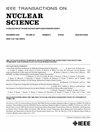Improvement on Analysis Method for X-Ray Arrival Spectrum From High-Altitude Nuclear Detonation
IF 1.9
3区 工程技术
Q3 ENGINEERING, ELECTRICAL & ELECTRONIC
引用次数: 0
Abstract
The study of the X-ray arrival spectrum of high-altitude nuclear detonation (HAND) shows that analytical methods offer advantages over Monte Carlo methods in terms of computation speed and the ability to invert the nuclear detonation source term. However, analytical methods have lower accuracy in calculating scattered X-rays in the spectrum arriving at the detector. To address this issue, an analytical method for correcting the X-ray arrival spectrum of HAND is proposed. This study employs a combined blackbody spectrum instead of a single blackbody spectrum to more accurately characterize the spectrum of the X-ray source from a hydrogen bomb detonation. A double-exponential fitting method is used instead of linear interpolation to obtain a more precise mass attenuation coefficient. Correction coefficients derived from Monte Carlo simulations to calibrate the arrival spectrum were corrected by the build-up factor (BUF). In the 2–130-keV energy range, the maximum relative errors between the Monte Carlo arrival spectrum and both the uncorrected for scattering and BUF-corrected arrival spectra are 84.9% and 100.2%, respectively. The proposed method reduces relative errors to within 15%, with a minimum error of less than 0.001%. In addition, its computation time is only 1/39600 of that of the Monte Carlo method. The proposed method provides a solid basis for designing, calibrating space-borne X-ray detectors and inverting the nuclear detonation yield.高空核爆x射线到达光谱分析方法的改进
对高空核爆x射线到达谱(HAND)的研究表明,解析方法在计算速度和核爆源项反演能力方面优于蒙特卡罗方法。然而,分析方法在计算到达探测器的光谱中的散射x射线时精度较低。针对这一问题,提出了一种修正HAND x射线到达谱的分析方法。本研究采用组合黑体光谱代替单一黑体光谱来更准确地表征氢弹爆炸的x射线源光谱。采用双指数拟合法代替线性插值法,可获得更精确的质量衰减系数。通过蒙特卡罗模拟得到的校正系数,利用累积因子(BUF)对到达光谱进行校正。在2 ~ 130 kev能量范围内,Monte Carlo到达光谱与未校正散射和buf校正的到达光谱的最大相对误差分别为84.9%和100.2%。该方法的相对误差减小到15%以内,最小误差小于0.001%。此外,其计算时间仅为蒙特卡罗方法的1/39600。该方法为星载x射线探测器的设计、标定和核爆当量反演提供了坚实的基础。
本文章由计算机程序翻译,如有差异,请以英文原文为准。
求助全文
约1分钟内获得全文
求助全文
来源期刊

IEEE Transactions on Nuclear Science
工程技术-工程:电子与电气
CiteScore
3.70
自引率
27.80%
发文量
314
审稿时长
6.2 months
期刊介绍:
The IEEE Transactions on Nuclear Science is a publication of the IEEE Nuclear and Plasma Sciences Society. It is viewed as the primary source of technical information in many of the areas it covers. As judged by JCR impact factor, TNS consistently ranks in the top five journals in the category of Nuclear Science & Technology. It has one of the higher immediacy indices, indicating that the information it publishes is viewed as timely, and has a relatively long citation half-life, indicating that the published information also is viewed as valuable for a number of years.
The IEEE Transactions on Nuclear Science is published bimonthly. Its scope includes all aspects of the theory and application of nuclear science and engineering. It focuses on instrumentation for the detection and measurement of ionizing radiation; particle accelerators and their controls; nuclear medicine and its application; effects of radiation on materials, components, and systems; reactor instrumentation and controls; and measurement of radiation in space.
 求助内容:
求助内容: 应助结果提醒方式:
应助结果提醒方式:


